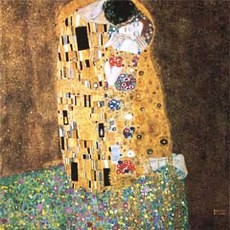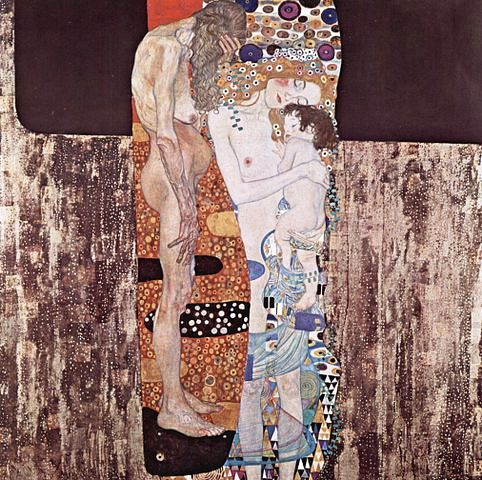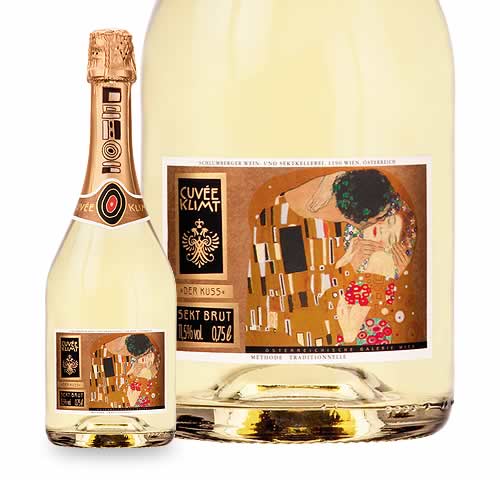Celebrating Gustav Klimt and the birth of Modernism

ROME-- Gustav Klimt (1862-1918), fin de siècle genius and pioneer of Viennese Modernism, would have celebrated his 150th birthday in 2012. His paintings – notably The Kiss, one of the world’s best-known pictures – are seen as epitomizing the spirit of change that heralded the dawn of the modernist era. In 2012 numerous museums in the Austrian capital will be staging special exhibitions to mark the anniversary year and the program has been recently introduced in Rome by Franz Smola, curator of collections of he Leopold Museum and by Jürgen R. Weber, of the Vienna Tourist Board ,assisted by Brigitte Wilhelmer, centre and south Italy market manager for he Austrian Tourist Office, ANTO.
With 22 pieces by the artist in its holdings, Vienna’s Belvedere is home to the world’s largest collections of paintings by Klimt. There are also major works on display at the Leopold Museum in the Museums Quartier, the Wien Museum and the Albertina. Contemporary documents and other exhibits at the Austrian Museum of Applied Arts/Contemporary Art (MAK) and the National Library reveal yet more about Klimt and his life. During 2012, Klimt’s anniversary year, visitors to Vienna will be able to experience how the artist and his circle – the Viennese modernist movement – continue to influence our thinking, and discover why this era has lost nothing of its allure.
All forms of high culture gravitated towards Vienna around 1900. Pioneering developments in the worlds of literature, the visual arts, architecture and music were taking place at a speed not seen since. In 1910 Vienna had a population of two million, making it the world’s fifth-largest city and the undisputed cultural capital of Central Europe. Gustav Klimt’s pictures reflect the artistic and scientific discoveries and developments that shaped the period. His oeuvre charts the course from the Ringstrasse era to the early days of abstraction: Influenced by Hans Makart, the defining Viennese painter of the late 19th century, Klimt, his brother Ernst, and Franz Matsch accepted a number of commissions to decorate buildings on Vienna’s showpiece Ringstrasse boulevard. The staircases of the Kunsthistorisches Museum and the Burgtheater are two outstanding examples of their work. Klimt’s creative output and the style he developed in later years paved the way for his younger contemporaries, Egon Schiele and Oskar Kokoschka.
The Secession and the Wiener Werkstätte
The legacy of Klimt and his fellow artists’ 1897 protest against an outdated view of art, which led to the foundation of the Secession movement, can be seen to this day. Created by Joseph Maria Olbrich, an employee of Otto Wagner, the new Secession Building exhibition hall bears the prescient motto, “to every age its art, to art its freedom.” Klimt contributed the building’s Beethoven Frieze. The architect Josef Hoffmann was one of the co-founders of the Secession movement. Together he and Klimt worked on the Palais Stoclet in Brussels – probably the definitive art nouveau Gesamtkunstwerk (total work of art). Klimt also had a major impact on the Wiener Werkstätte (established in 1903 by Hoffmann and Kolo Moser); the firm was to change the face of design forever.
Works by these artists and their contemporaries are not confined to Vienna’s museums and exhibition halls, they have had a lasting impact on the cityscape. Society, too, was undergoing dramatic changes at the turn of the century. Klimt’s depictions of women reveal the emergence of an increasingly self-confident middle class. His 1898 portrait of Sonja Knips elevated him to the role of the portraitist of a well-heeled Viennese bourgeoisie. His likenesses of Fritza Riedler and Adele Bloch-Bauer (one of the most expensive paintings in the world) have lost nothing of their appeal to this day. The same goes for his pictures of his longstanding companion, Emilie Flöge, a modern, emancipated woman.
Gustav Klimt in Vienna
A large number of works by Gustav Klimt, particularly from his early period, are on permanent display at some of Vienna’s leading cultural institutions. The Secession is one of Vienna’s most beautiful landmarks. Klimt, a co-founder of the Secessionist movement, created his world-famous 1902 Beethoven Frieze for the building. The cycle, dedicated to the composer, adorns three walls and measures approximately 34 by two meters. (Secession, Friedrichstrasse 12, 1st district, www.secession.at).
In the stairwell of the Kunsthistorisches Museum there are some 40 spandrel paintings and other decorative works in the narrow sections of wall between the archways and columns. Eleven of these are by Gustav Klimt, and the remainder by his brother Ernst and Franz Matsch. The images depict the history of the fine and applied arts from their ancient Egyptian beginnings to the modern age. (Kunsthistorisches Museum, Maria-Theresien-Platz, 1st district, www.khm.at).
Priceless sketches by Gustav Klimt for the ceiling paintings above the grand staircase of the Burgtheater were discovered in the theater’s attic in the late 1990s, rescuing them from decay. Today the drawings, which include the artist’s only self-portrait, are exhibited in a separate Klimt room. They can be viewed as part of a guided tour that also takes in the ceiling paintings above the grand staircase. (Burgtheater, Dr.-Karl-Lueger-Ring 2, 1st district, www.burgtheater.at).
Josef Hoffmann and Gustav Klimt joined forces to work on the Palais Stoclet in Brussels, for which Klimt created the Stoclet Frieze between 1905 and 1909. His nine working sketches for the project are on display in Vienna at the Austrian Museum of Applied Arts/Contemporary Art (MAK). The latter also owns the estate of the world-famous Wiener Werkstätte, which includes studies, model books, photographic volumes, original fabric patterns, embroideries and the entire company archive. In 2012 the MAK will again be showing a large number of objects created by the Wiener Werkstätte, including furniture, vases, ceramic tableware and postcards by Josef Hoffmann, Kolo Moser, Dagobert Peche and other collaborators of the Wiener Werkstätte. (MAK, Stubenring 5, 1st district, www.mak.at).
Gustav Klimt’s last studio, which he used from 1911 until his death in 1918, is scheduled to reopen in time for the 150th anniversary of his death (July 7, 2012) after comprehensive renovation. The ground floor of the building, in Feldmühlgasse in the 13th district, will house a special area designed to give visitors an authentic taste of the artist’s working and home environment. (Klimt Villa, Feldmühlgasse 15a, 13th district, www.klimt.at).
Special Klimt exhibitions in 2012
Many Vienna museums and galleries will be staging special shows during the 2012 anniversary year in addition to the works that are on permanent display in the city (for all the latest information visit www.klimt2012.info/en):
Belvedere
The Belvedere is home to the world’s largest collection of Klimts (including The Kiss), and will be focusing on the world-famous artist, as well as like-minded architect and designer Josef Hoffmann, in an exhibition, to be held from October 25, 2011 and March 4, 2012. The close working relationship between the two, which included the Beethoven Exhibition (1902) at the Secession and the Palais Stoclet (1905–1912) in Brussels, became the models for the Gesamtkunstwerk. Numerous works, such as Klimt’s portrait of Fritza Riedler which clearly reflects Hoffmann’s style, show the influence that these two pioneers of Austrian modernism had on each other – a subject to be explored by a large special exhibition with an additional Wiener Werkstätte focus.
Gustav Klimt/Josef Hoffmann. Pioneers of Modernism, Oct. 25, 2011–Mar. 4, 2012, Belvedere, Lower Belvedere, Rennweg 6, 3rd district, www.belvedere.at.
Kunsthistorisches Museum (Museum of Fine Arts)
The Gustav Klimt at the Kunsthistorisches Museum exhibition is devoted to the artist’s intermediate period (1886-1897). Klimt’s 13 major paintings from this era and study sketches for the grand staircase of the museum are given centre stage. In 1890 Klimt, his brother Ernst, and Franz Matsch won a commission for the spandrel paintings and other works to decorate the narrow spaces between the columns lining the stairway. These images provided the stylistic point of departure for Gustav Klimt’s famous works completed around and after the turn of the century. Klimt’s drawings were last shown in Zurich in 1992. A series of loan pieces are used to illustrate the genesis of these works and explain his choice of motifs while giving an insight into the stylistic space occupied by them in his portfolio. The spandrel paintings in the Museum of Fine Arts can be viewed all year round.
Gustav Klimt at the Museum of Fine Arts, Feb 14-May 6, 2012, Kunsthistorisches Museum/Museum of Fine Arts, Maria-Theresien-Platz, 1st district, www.khm.at.
Leopold Museum
The Leopold Museum will be hanging major works by Egon Schiele and several other Secession artists alongside paintings by Gustav Klimt. The Gustav Klimt. A Journey Through Time exhibition features many exhibits from the estate of Klimt’s lifelong companion Emilie Flöge including examples of the artist’s prolific correspondence (Klimt sometimes sent his muse several postcards in a single day). These “travel logs” will be related to important drawings and pictures.
Gustav Klimt. A Journey Through Time, Feb. 24–June 11, 2012, Leopold Museum, MuseumsQuartier, Museumsplatz 1, 7th district, www.leopoldmuseum.org.
Albertina
From March 14 to June 13, 2012 the Albertina – a centre of research into Gustav Klimt’s drawings – will show most of the 170 works by the artist in its collection, providing an excellent cross-section of all his oeuvre during every stage of his career. The pieces from the Albertina’s holdings will be complemented by a carefully selected loan exhibits. The focus will be on Gustav Klimt’s unique draughtsmanship. The artist’s thinking and technique will be revealed by the many figure studies and the mannered execution of the allegorical works.
Klimt: Drawings, Mar 14–Jun 10, 2012, Albertina, Albertinaplatz 1, 1st district, www.albertina.at.
Österreichisches Theatermuseum/Austrian Theater Museum
Gustav Klimt’s famous painting ”Nuda Veritas” will form the centerpiece of the “Against Klimt. Nuda Veritas and Her Defender Hermann Bahr” exhibition at the Austrian Theater Museum. The naked truth in the form of a striking, two-meter tall woman, holds a mirror to the beholder. The show also explores the seminal role played by this work in the art of the turn of the 19th and 20th century. “Nuda Veritas” is part of the estate of the writer Hermann Bahr, which is held by the Austrian Theater Museum. Bahr was a friend of Klimt and a major patron of contemporary art. He examined the controversy surrounding Klimt’s work in an essay entitled “Against Klimt”. His creative output will also feature prominently in this exhibition.
Against Klimt. Nuda Veritas and her Defender Hermann Bahr, May 10-Oct. 29, 2012, Österreichisches Museum für Volkskunde/Austrian Theater Museum, Lobkowitzplatz 2, 1st district, www.theatermuseum.at
Wien Museum
The Wien Museum owns a high-caliber Klimt collection, which will go on public display in its entirety for the first time during the Klimt anniversary year in an exhibition entitled “KLIMT. The Wien Museum Collection.” The museum has the world's largest collection of drawings by Klimt, comprising some 400 works representing every stage of the artist’s creative development. The sketches will be presented alongside a number of his paintings including the Portrait of Emilie Flöge. Among the other exhibits are poster designs and prints, his smock, his death mask, a cast of his right hand, and a posthumous sketch of him by Egon Schiele.
Klimt. The Wien Museum Collection, May 15-Sept. 16, 2012, Wien Museum, Karlsplatz, 1st district, www.wienmuseum.at
Österreichisches Museum für Volkskunde (Austrian Folklore Museum)
The Austrian Folklore Museum has 350 textile samples (embroideries, lacework, trims) from the estate of Emilie Flöge. Klimt’s partner was the owner of the Schwestern Flöge the Viennese haute couture salon on Mariahilfer Strasse, an upscale dressmakers catering to the capital’s high society. These precious samples will be on display for the first time at a new exhibition called Objects in Focus – The Emilie Flöge Fabric Sample Collection.
Objects in Focus – The Emilie Flöge Fabric Sample Collection. May 25-Oct. 14, 2012, Österreichisches Museum für Volkskunde/Austrian Folklore Museum, Laudongasse 15-19, 8th district, www.volkskundemuseum.at.
Künstlerhaus
Gustav Klimt was a member of the Künstlerhaus from 1891–1897. Many documents from this period have been preserved. The Künstlerhaus on Karlsplatz will be staging an exhibition entitled Klimt and the Künstlerhaus from July 6 to Sept. 2, 2012. On view will be letters, photographs and other records of Klimt’s work at the Künstlerhaus.
Klimt and the Künstlerhaus, July 6–September 2, 2012, Künstlerhaus, Karlsplatz 5, 1st district, www.k-haus.at.




